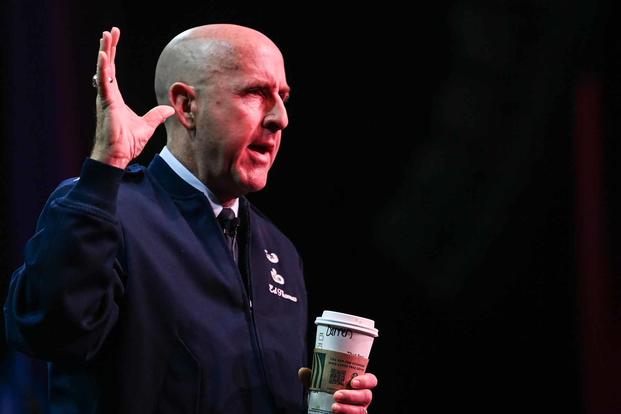The Air Force will fall short of its recruiting goals for its National Guard and reserve components this year, as the military as a whole struggles to get Americans to enlist in the armed services.
While the Air Force will meet its active-duty numbers by the start of fiscal 2023 on Oct. 1, Maj. Gen. Ed Thomas, the commander of the Air Force Recruiting Service, told reporters at the Air Force Association's Air, Space & Cyber Conference on Wednesday that the branch will be behind between 1,500 to 2,000 airmen for each component of the reserve and Guard.
Thomas said the Guard and reserve numbers were harmed by "recruiting headwinds that we've been dealing with" and added that "it was never a given this year that we weren't going to meet our recruiting goal."
Read Next: Air Force Pay Cuts Canceled
While the Air Force is in a better position than other services in terms of its end-of-year goals, it will be a short sigh of relief. The branch has already dipped into its bank of recruits who have delayed entry into the service.
Thomas said the Air Force Recruiting Service typically has around 25% of its recruits ready to begin training by the start of the year -- in part due to the delayed-entry program -- but that number has dwindled to 10% for the start of fiscal 2023.
"I would say that we're doing a dead stick landing as we come into the end of fiscal year 2022," Thomas said, describing an emergency aircraft landing in which a pilot must maneuver an airplane to the ground without its engines. "We have the 30th of September, and we're going to need to turn around on the first of October and do an afterburner takeoff."
Thomas said a highly competitive civilian job market brought on by the coronavirus pandemic, as well as not being able to reach as many people through recruiting events during the height of the pandemic, is primarily to blame.
But there are other factors at play as well.
Fewer Americans are seemingly interested in joining the ranks. Sen. Thom Tillis, R-N.C., the ranking member of the Senate Armed Services Committee personnel panel, said during an April hearing -- citing Pentagon information -- that just 8% of young Americans have seriously considered joining the military.
Only about one-quarter of young Americans are even eligible for service these days, a shrinking pool limited by an increasing number of potential recruits who are overweight or are screened out due to minor criminal infractions, including the use of recreational drugs such as marijuana.
In an effort to drum up interest, the branches have opened up their wallets.
Earlier this year, the Air Force began offering hefty bonuses to help fill the ranks, including $50,000 for some of the service's most dangerous jobs and substantial bonuses for cyber professionals.
Recruiting woes were also felt at the Air Force Academy, where applications to be part of the next class dropped by 28% from the prior year.
Conservative commentators and media have frequently criticized recent policy changes, such as the coronavirus vaccine mandate; making uniforms and job opportunities more inclusive for women; and efforts to support diversity in the ranks as harming recruiting, criticisms that Thomas said are inaccurate.
"I would tie this back to a polarization that we're seeing in our country, and it kind of hurts my heart to hear those kinds of things," he said. "Like society, the military is a reflection of society; it's changing all the time."
Late last month, the Department of the Air Force set new demographic goals in hopes of getting more diverse applicants for its officer corps, which has historically been largely populated by white males.
It marks the first time in nearly a decade that the Department of the Air Force has updated its demographic targets for officer applicants.
"We're already struggling with a [civilian/military] divide," Thomas said. "And that divide grows even worse, especially if 20 years from now you continue to look at the military leadership and we don't look like America."
-- Thomas Novelly can be reached at thomas.novelly@military.com. Follow him on Twitter @TomNovelly.
Related: The Air Force and Space Force Have New Diversity Targets for Their Officer Corps













